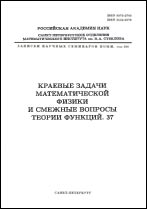|
|
Zapiski Nauchnykh Seminarov POMI, 1998, Volume 250, Pages 161–190
(Mi znsl649)
|
 |
|
 |
This article is cited in 1 scientific paper (total in 1 paper)
Abel–Lidskii bases in non-selfadjoint inverse boundary problem
Ya. V. Kuryleva, M. Lassasb
a St. Petersburg Department of V. A. Steklov Institute of Mathematics, Russian Academy of Sciences
b Rolf Nevanlinna Institute, Department of Mathematics and Statistics,
University of Helsinki
Abstract:
Let $M$ be a manifold with bondary $\partial M\ne\varnothing$. Let $A$ be a 2-nd order elliptic PDO on $M$. Denote by $R_\lambda(x,y)$, $x$, $y\in M$, $\lambda\in\mathbb C\setminus\sigma(A)$ the Schwartz kernel of
$(A-\lambda I)^{-1}$. We consider the Gel'fand inverse boundary problem of the reconstruction of $(M,A)$ via given $R_\lambda(x,y)$, $x$, $y\in\partial M$, $\lambda\in\mathbb C$. We prove that if the main symbol of
$A$ satisfies some geometrical condition (Bardos–Lebeau–Rauch condition) then these data determine $M$ uniquely and $A$ to within the group of the generalized gauge transformations on $M$. The above mentioned geometric condition means, roughly speaking, that any geodesics (in the metric generated by $A$) leaves $M$.
Received: 16.10.1997
Citation:
Ya. V. Kurylev, M. Lassas, “Abel–Lidskii bases in non-selfadjoint inverse boundary problem”, Mathematical problems in the theory of wave propagation. Part 27, Zap. Nauchn. Sem. POMI, 250, POMI, St. Petersburg, 1998, 161–190; J. Math. Sci. (New York), 102:4 (2000), 4237–4257
Linking options:
https://www.mathnet.ru/eng/znsl649 https://www.mathnet.ru/eng/znsl/v250/p161
|

| Statistics & downloads: |
| Abstract page: | 162 | | Full-text PDF : | 66 |
|




 Contact us:
Contact us: Terms of Use
Terms of Use
 Registration to the website
Registration to the website Logotypes
Logotypes








 Citation in format
Citation in format 
